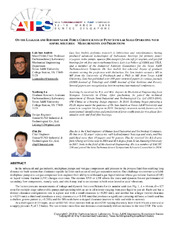| dc.description.abstract | In the subsea oil and gas industry, multiphase pumps and wet gas compressors add pressure to the process fluid thus enabling long
distance tie back system that eliminates topside facilities such as an oil and gas separation station. One challenge to construct a reliable
multiphase pump or a wet gas compressor is to engineer their ability to withstand a gas-liquid mixture whose gas volume fraction (GVF)
or liquid volume fraction (LVF) changes over time. The mixture GVF or LVF affects the static and dynamic forced performance of
secondary flow components, namely seals, and which may lead to an increase in both rotor lateral or axial vibrations.
The lecture presents measurements of leakage and dynamic force coefficients for six annular seals (see Fig. 1, L = 46 mm, D = 127
mm) for multiple-stage submersible pumps and operating with an air in oil mixture ranging from pure liquid to just air. Each seal has a
distinct clearance configuration: one is a plain seal with a small clearance (c=0.203 mm), and another has a larger (worn) clearance
(c=0.274 mm); a third seal introduces a wavy clearance (cm= 0.191 mm) that produces a significant centering stiffness; a fourth seal has
a shallow groove pattern (cr=0.211); and the fifth seals have a stepped clearance (narrow to wide and wide to narrow).
At a shaft speed of 3.5 krpm, an air in ISO VG 10 oil mixture with an inlet GVF varying discretely from 0 to 0.9 feeds a test seal at
a supply pressure Ps of 2.5 bar(a). The test mixture mass flow rate decreases continuously with an increase in the inlet GVF. The seals
Copyright© 2018 by Turbomachinery Laboratory, Texas A&M Engineering Experiment Station
2
operating with a pure liquid (GVF=0) show frequency independent force coefficients. On the other hand, operation with a mixture
produces direct and cross-coupled stiffnesses that vary greatly with frequency, in particular the direct stiffness hardens with excitation
frequency. The direct damping coefficients, on the other hand, are not functions of excitation frequency, albeit dropping rapidly in
magnitude as the GVF increases.
The lecture details comparisons of leakage and force coefficients among the various test seals. The three-wave seal produces the
greatest direct stiffness and damping coefficients, as well as the largest effective damping coefficient. The worn surface (largest
clearance) seal produces the smallest force coefficients and leaks the most. Operation with a large GVF produces little damping, albeit
more than predicted. For all the test seals, the whirl frequency ratio is around 50%.
The step clearance seal (with the narrow clearance facing the incoming flow produces a significant negative direct stiffness that
could easily impact the static stability of a pump as it reduces its natural frequency.
Predictions of seal force coefficients derived from a homogeneous bulk flow match well with the test data for operation with a pure
oil and a small GVF ~ 0.2. The discrepancy between the prediction and test data grows rapidly for operation with a larger gas content,
GVF > 0.2. Hence, more accurate predictive models are in urgent need of development.
The experimental results reveal the best characteristics of certain annular seal configurations, thus aiding to better design and
understand the operation of centrifugal pumps handing multiple-phase flows. | en |


